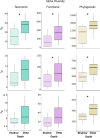Deep reefs are not refugium for shallow-water fish communities in the southwestern Atlantic
- PMID: 33976819
- PMCID: PMC8093723
- DOI: 10.1002/ece3.7336
Deep reefs are not refugium for shallow-water fish communities in the southwestern Atlantic
Abstract
The deep reef refugia hypothesis (DRRH) predicts that deep reef ecosystems may act as refugium for the biota of disturbed shallow waters. Because deep reefs are among the most understudied habitats on Earth, formal tests of the DRRH remain scarce. If the DRRH is valid at the community level, the diversity of species, functions, and lineages of fish communities of shallow reefs should be encapsulated in deep reefs.We tested the DRRH by assessing the taxonomic, functional, and phylogenetic diversity of 22 Brazilian fish communities between 2 and 62 m depth. We partitioned the gamma diversity of shallow (<30 m) and deep reefs (>30 m) into independent alpha and beta components, accounted for species' abundance, and assessed whether beta patterns were mostly driven by spatial turnover or nestedness.We recorded 3,821 fishes belonging to 85 species and 36 families. Contrary to DRRH expectations, only 48% of the species occurred in both shallow and deep reefs. Alpha diversity of rare species was higher in deep reefs as expected, but alpha diversity of typical and dominant species did not vary with depth. Alpha functional diversity was higher in deep reefs only for rare and typical species, but not for dominant species. Alpha phylogenetic diversity was consistently higher in deep reefs, supporting DRRH expectations.Profiles of taxonomic, functional, and phylogenetic beta diversity indicated that deep reefs were not more heterogeneous than shallow reefs, contradicting expectations of biotic homogenization near sea surface. Furthermore, pairwise beta-diversity analyses revealed that the patterns were mostly driven by spatial turnover rather than nestedness at any depth. Conclusions. Although some results support the DRRH, most indicate that the shallow-water reef fish diversity is not fully encapsulated in deep reefs. Every reef contributes significantly to the regional diversity and must be managed and protected accordingly.
Keywords: coral reefs; depth; fish; mesophotic coral ecosystems.
© 2021 The Authors. Ecology and Evolution published by John Wiley & Sons Ltd.
Conflict of interest statement
The authors declare that there is no conflict of interest.
Figures





Similar articles
-
Exploring depth-related patterns of sponge diversity and abundance in marginal reefs.Ecol Evol. 2024 Jul 2;14(7):e11643. doi: 10.1002/ece3.11643. eCollection 2024 Jul. Ecol Evol. 2024. PMID: 38957700 Free PMC article.
-
Hydroids (Cnidaria, Hydrozoa) from Mauritanian Coral Mounds.Zootaxa. 2020 Nov 16;4878(3):zootaxa.4878.3.2. doi: 10.11646/zootaxa.4878.3.2. Zootaxa. 2020. PMID: 33311142
-
Effects of depth on reef fish communities: Insights of a "deep refuge hypothesis" from Southwestern Atlantic reefs.PLoS One. 2018 Sep 26;13(9):e0203072. doi: 10.1371/journal.pone.0203072. eCollection 2018. PLoS One. 2018. PMID: 30256788 Free PMC article.
-
The flourishing and vulnerabilities of zoantharians on Southwestern Atlantic reefs.Mar Environ Res. 2022 Jan;173:105535. doi: 10.1016/j.marenvres.2021.105535. Epub 2021 Nov 24. Mar Environ Res. 2022. PMID: 34879290 Review.
-
The hidden half: ecology and evolution of cryptobenthic fishes on coral reefs.Biol Rev Camb Philos Soc. 2018 Nov;93(4):1846-1873. doi: 10.1111/brv.12423. Epub 2018 May 7. Biol Rev Camb Philos Soc. 2018. PMID: 29736999 Review.
Cited by
-
eDNA metabarcoding shows highly diverse but distinct shallow, mid-water, and deep-water eukaryotic communities within a marine biodiversity hotspot.PeerJ. 2025 Apr 22;13:e19249. doi: 10.7717/peerj.19249. eCollection 2025. PeerJ. 2025. PMID: 40292110 Free PMC article.
-
Interconnected marine habitats form a single continental-scale reef system in South America.Sci Rep. 2022 Oct 17;12(1):17359. doi: 10.1038/s41598-022-21341-x. Sci Rep. 2022. PMID: 36253396 Free PMC article.
-
Black coral forests enhance taxonomic and functional distinctiveness of mesophotic fishes in an oceanic island: implications for biodiversity conservation.Sci Rep. 2023 Mar 27;13(1):4963. doi: 10.1038/s41598-023-32138-x. Sci Rep. 2023. PMID: 36973395 Free PMC article.
-
Exploring depth-related patterns of sponge diversity and abundance in marginal reefs.Ecol Evol. 2024 Jul 2;14(7):e11643. doi: 10.1002/ece3.11643. eCollection 2024 Jul. Ecol Evol. 2024. PMID: 38957700 Free PMC article.
-
Comprehensive spatial distribution of tropical fish assemblages from multifrequency acoustics and video fulfils the island mass effect framework.Sci Rep. 2022 May 24;12(1):8787. doi: 10.1038/s41598-022-12409-9. Sci Rep. 2022. PMID: 35610249 Free PMC article.
References
-
- Albouy, C. , Leprieur, F. , Le Loc'h, F. , Mouquet, N. , Meynard, C. N. , Douzery, E. J. P. , & Mouillot, D. (2015). Projected impacts of climate warming on the functional and phylogenetic components of coastal Mediterranean fish biodiversity. Ecography, 38(7), 681–689. 10.1111/ecog.01254 - DOI
-
- Andradi‐Brown, D. , Beer, A. , Colin, L. , Head, C. , Hidayat, N. I. , Lindfield, S. , & Ahmadia, G. (2019). Highly diverse mesophotic reef fish communities in Raja Ampat, West Papua. BioRxiv, 640490. 10.1101/640490 - DOI
-
- Araújo, M. E. , Mattos, F. M. G. , Melo, F. P. L. , Chaves, L. C. T. , Feitosa, C. V. , Lippi, D. L. , Hackradt, F. C. F. , Hackradt, C. W. , Nunes, J. L. S. , Leão, Z. M. A. N. , Kikuchi, R. K. P. , Junior, A. V. F. , Pereira, P. H. C. , Macedo, C. H. R. , Sampaio, C. L. S. , & Feitosa, J. L. L. (2020). Diversity patterns of reef fish along the Brazilian tropical coast. Marine Environmental Research, 160, 105038. 10.1016/j.marenvres.2020.105038 - DOI - PubMed
-
- Asher, J. , Williams, I. D. , & Harvey, E. S. (2017). Mesophotic depth gradients impact reef fish assemblage composition and functional group partitioning in the Main Hawaiian Islands. Frontiers in Marine Science, 4, 1–18. 10.3389/fmars.2017.00098 - DOI
LinkOut - more resources
Full Text Sources
Other Literature Sources

